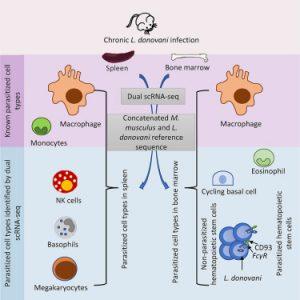Leishmaniasis, a parasitic disease primarily known for its disfiguring skin manifestations, harbors a secret weapon in its more severe form, visceral leishmaniasis. New research reveals that the parasites causing this potentially deadly disease have a remarkable ability to infect non-immune cells and endure in these unusual hideouts.
In a new study, researchers made a new discovery: the Leishmania donovani parasites reside within blood-related stem cells nestled in the bone marrow of chronically infected mice (Figure 1). These unique stem cells possess the remarkable ability to regenerate various types of cells within the blood-forming system. The unearthing of these parasitic invaders may offer insights into the often accompanying blood disorders, such as anemia, in individuals afflicted with visceral leishmaniasis.
The revelation of these peculiar hiding spots for Leishmania parasites enriches our comprehension of the disease and may pave the way for novel treatment approaches. Traditional antiparasitic drugs may not effectively target these distinct cells, possibly fostering an environment where parasites can adapt and thrive. To halt disease transmission effectively, the elimination of these concealed parasites becomes crucial.
Leishmaniasis is not a uniform disease but encompasses two distinct forms. Cutaneous leishmaniasis, caused by Leishmania major parasites, affects approximately 1.2 million people annually in tropical regions, leading to disfiguring skin ailments. Conversely, L. donovani parasites trigger visceral leishmaniasis, a rarer form that attacks internal organs, impacting an estimated 100,000 individuals each year.
Researchers used single-cell RNA sequencing, a cutting-edge method, to hunt for parasites in spleen and bone marrow cells in chronically infected mice. This technique allowed scientists to distinguish specific cell types based on the genes expressed within each type. In a simultaneous revelation, researchers identified which cells were infected by L. donovani parasites by examining the presence or absence of genes characteristically expressed by these organisms.
The study unveiled that the parasites didn’t confine themselves solely to phagocytic cells responsible for devouring invaders. Within the bone marrow, blood-related stem cells were the primary reservoir of these parasites. These cells, intriguingly, bear some similarities in their outer surface receptors to the immune cells that are typically targeted by these intruders.
This study reveals that Leishmania parasites’ ability to seek refuge in unexpected cells significantly impacts the disease’s dynamics. Understanding their hidden hideaways offers a new perspective and potential avenues for treatment in the fight against visceral leishmaniasis.
Journal article: Karagiannis, K., et al. 2023. Dual-scRNA-seq analysis reveals rare and uncommon parasitized cell populations in chronic L. donovani infection. Cell Reports.
Summary by Stefan Botha











